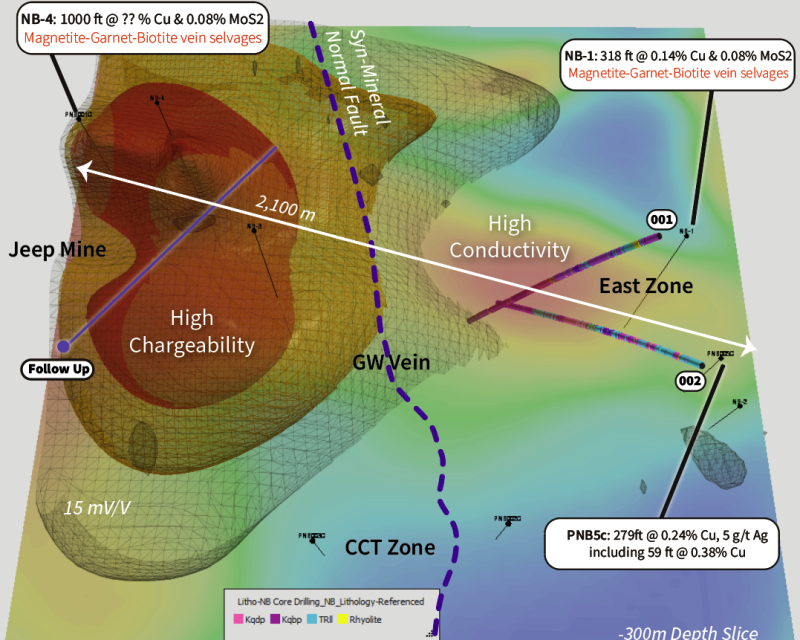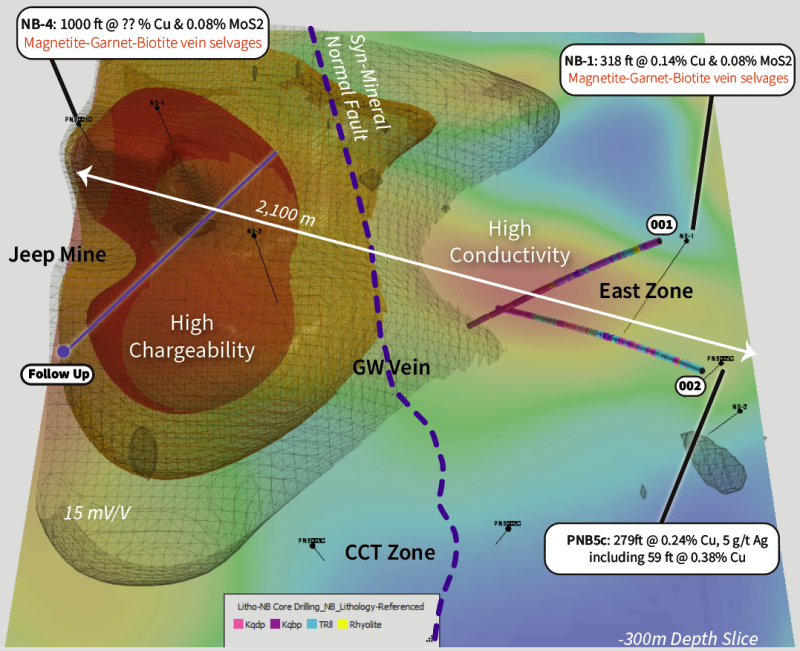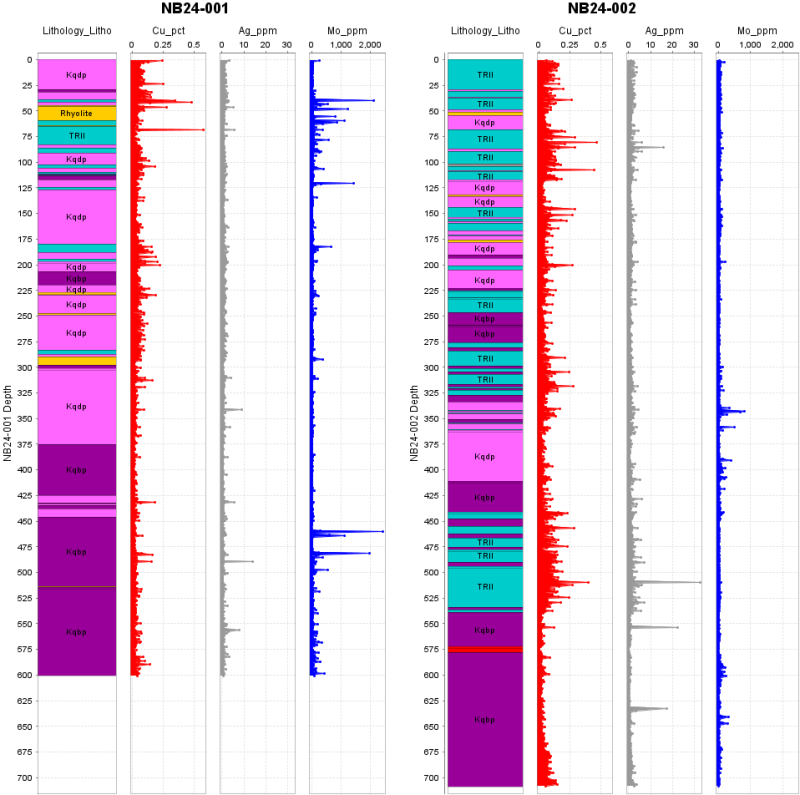 |
|||||||||
Sept 10, 2024, Vancouver, BC – TheNewswire: VR Resources Ltd. (TSX.V: VRR, FSE: 5VR; OTCQB: VRRCF), the “Company“, or “VR”, has received all geochemical data from its recently completed drill program at the New Boston porphyry copper-moly-silver project in Nevada.
Two reconnaissance drill holes were completed for a total of 1,310 metres on the eastern end of the polymetallic porphyry-skarn mineral system exposed on surface at New Boston over a strike length of 3 – 4 kilometres. The two holes test the East Zone conductor identified in a state-of-the-art 3D array DCIP survey completed in 2023, along two different structural pathways for hydrothermal fluids.
From VR’s CEO, Justin Daley
“Having logged every inch of both reconnaissance drill holes into the East Zone conductor, the intensity of veining and alteration and the potential in this large, fertile polymetallic system was most striking. Broad, continuous low-grade mineralization through the entirety of each hole is underscored by local grade intensity of copper, moly and silver in skarn mineralization of completely recrystallized limestone. Finally, New Boston is dynamic, with multiple phases of monzonite porphyry in both holes showing distinct mineralization and potential across the GW trend.
We know what to do next. The porphyry intrusions of the East Zone conductor plunge westerly towards the GW fold structure in the center of the property, with copper-bearing gossans occurring at surface, and evident at the top of our drill holes in the East Zone bowl. The IP anomaly at Jeep Mine is cored by increasing conductivity at depth; the Jeep Mine and East Zone conductivity features are modeled to have a common source associated with the central GW fault system. Why? Because mineralized monzonite porphyry is predominant in both of our drill holes down plunge and grade increases steadily in hole 2 as it approaches the central GW structure.
To that end, we have scoped an MT survey to augment our DCIP survey completed in 2023 in order to give us a more complete picture of where the mineralized porphyry intrusions appear to coalesce below Jeep and GW. The exploration model and guide for follow-up drilling is summarized in the DCIP profile in Figure 1.”
Continuous geochemical sampling of drill core was completed across both holes. Summary graphic logs are shown in Figure 2. Key findings include:
-
Continuous hydrothermal mineralization and potassic alteration starting at surface.
-
All 563 samples across 601 m (1,972 ft) in Hole 001 have hydrothermal mineralization. Copper averages 0.05% with max 0.60%, and 1.0 g/t Ag with up to 14 g/t, & 76 ppm Mo on average.
-
All 620 samples across 709 m (2,326 ft) in Hole 002 have hydrothermal mineralization, Copper averages 0.07% with max 0.50%, and 1.5 g/t Ag with up to 32.7 g/t, & 35 ppm Mo on average.
-
-
Copper-moly-silver mineralization in limestone host rock.
-
48m @ 0.11% Cu, 115 ppm Mo 1.55 g/t Ag from 0 m (surface) in Hole 001 (photo in Figure 3).
-
117.6m @ 0.10% Cu, 118 ppm Mo 1.9 g/t Ag from 1 min Hole 002.
-
98m @ 0.12% Cu, 24 ppm Mo 2.3 g/t Ag from 441 m in Hole 002. (photo in Figure 4)
-
Technical Information
Summary technical and geological information for the Company’s various exploration properties including New Boston is available at the Company’s website at www.vrr.ca.
VR submits all surface grab samples and/or drill core samples collected from Nevada-based exploration projects for geochemical analysis to the ALS Global (“ALS”) laboratory in Reno, Nevada. Sample preparation is completed in Reno. Analytical work is completed at the ALS laboratories located in Vancouver, BC., including ICP-MS analyses for base metals and trace elements, and gold determination by atomic absorption assay. Analytical results are subject to industry-standard and NI 43-101 compliant QAQC sample procedures, including the systematic insertion of sample duplicates, blanks and certified reference material (CRM) done both externally on the project site by the Company and internally at the laboratory by ALS, as described by ALS.
Technical information for this news release has been prepared in accordance with the Canadian regulatory requirements set out in National Instrument 43-101. Justin Daley, P.Geo., President & CEO and a non-independent Qualified Person oversees and/or participates in all aspects of the Company’s mineral exploration projects, and the content of this news release has been reviewed on behalf of the Company by the Executive Chairman, Dr. Michael Gunning, P.Geo., a non-independent Qualified Person.
About the New Boston Property
Location
New Boston is within the Walker Lane mineral belt and structural province in west-central Nevada. More specifically, it is within the co-spatial belts of Jurassic – and Cretaceous-aged copper and moly porphyry deposits, including the Yerington camp to the northwest and the Hall deposit to the southeast.
New Boston is located in the Garfield Range in Mineral County, and is approximately 150 km southeast of Reno. Vegetation is sparse in the range; outcrop or colluvium predominate on the property itself, with quaternary cover present to the east in the Soda Spring valley.
The property location facilitates cost-effective, year-round exploration. Access is from the nearby town of Luning, located just 5 km to the east on State Highway 95 which connects Reno and Las Vegas. The property is criss-crossed by a myriad of historic trails and roads which are driveable from the highway.
Description
The New Boston property is large. It consists of 77 claims in one contiguous block approximately 1.5 x 3 km in size and covering 583 hectares in total (1,441 acres). It covers the entire along-strike and down-dip extent of the polymetallic Cu-Mo-Ag sheeted and stockwork veins east of the Blue Ribbon skarns on the westernmost end of the porphyry-skarn system exposed on surface across a 3 – 4 km strike.
The property is on federal land administered by the Bureau of Land Management (BLM). There are no state or federal land use designations, or privately-owned land which impede access to the property; nor is the property within the BLM’s broadly defined area of sage grouse protection.
The property is owned 100% by VR. There are no underlying annual lease payments; nor are there any joint venture or back-in interests. The vendor of the property retains a royalty.
About VR Resources
VR is an established junior exploration company based in Vancouver (TSX.V: VRR; Frankfurt: 5VR; OTCQB: VRRCF). VR evaluates, explores and advances large-scale, blue-sky opportunities in copper, gold and critical metals in Nevada, USA, and Ontario, Canada, and more recently, Canada’s newest discovery of a diamond-bearing kimberlite pipe at its Northway project. VR applies modern exploration technologies and leverages in-house experience and expertise in greenfields exploration to large-footprint mineral systems in underexplored areas/districts. The foundation of VR is the proven track record of its Board in early-stage exploration, discovery and M&A. The Company is financed for its mineral exploration and corporate obligations. VR owns its properties outright and evaluates new opportunities on an ongoing basis, whether by staking or acquisition.
Further information can be found on the company’s website www.vrr.ca
ON BEHALF OF THE BOARD OF DIRECTORS:
“Justin Daley”
Justin Daley, MSc, PGeo
President & CEO
For general information please use the following:
Website: www.vrr.ca
Email: [email protected]
Phone: 778-731-9292
Forward Looking Statements
This news release contains statements that constitute “forward-looking statements”. Such forward looking statements involve known and unknown risks, uncertainties and other factors that may cause the Company’s actual results, performance or achievements, or developments in the industry to differ materially from the anticipated results, performance or achievements expressed or implied by such forward-looking statements. Forward-looking statements are statements that are not historical facts and are generally, but not always, identified by the words “expects,” “plans,” “anticipates,” “believes,” “intends,” “estimates,” “projects,” “potential” and similar expressions, or that events or conditions “will,” “would,” “may,” “could” or “should” occur. Forward-looking statements in this document include statements concerning VR’s plans for new geophysics at its New Boston and Bonita properties, and all other statements that are not statements of historical fact.
Although the Company believes the forward-looking information contained in this news release is reasonable based on information available on the date hereof, by their nature forward-looking statements involve assumptions, known and unknown risks, uncertainties and other factors which may cause our actual results, performance or achievements, or other future events, to be materially different from any future results, performance or achievements expressed or implied by such forward-looking statements.
Examples of such assumptions, risks and uncertainties include, without limitation, assumptions, risks and uncertainties associated with general economic conditions; the Covid-19 pandemic; adverse industry events; future legislative and regulatory developments in the mining sector; the Company’s ability to access sufficient capital from internal and external sources, and/or inability to access sufficient capital on favorable terms; mining industry and markets in Canada and generally; the ability of the Company to implement its business strategies; competition; and other assumptions, risks and uncertainties.
The forward-looking information contained in this news release represents the expectations of the Company as of the date of this news release and, accordingly, is subject to change after such date. Readers should not place undue importance on forward-looking information and should not rely upon this information as of any other date. While the company may elect to, it does not undertake to update this information at any particular time except as required in accordance with applicable laws.
This news release may also contain statements and/or information with respect to mineral properties and/or deposits which are adjacent to and/or potentially similar to the Company’s mineral properties, but which the Company has no interest in nor rights to explore. Readers are cautioned that mineral deposits on similar properties are not necessarily indicative of mineral deposits on the Company’s properties.
Trading in the securities of the Company should be considered highly speculative. All of the Company’s public disclosure filings may be accessed via www.sedarplus.ca and readers are urged to review them.
Neither the TSX Venture Exchange nor its Regulation Services Provider (as that term is defined in Policies of the TSX Venture Exchange) accepts responsibility for the adequacy or accuracy of this release
—–
Figure 1. Traces for drill holes 001 and 002 completed at New Boston in 2024. The drill holes traverse both down and across the East Zone conductor derived from the 3D-array survey completed in the spring of 2023. The East Zone conductor plunges westerly towards the central GW fault structure, with copper-bearing gossans occurring in the East Zone bowl where it comes to surface, approximately 3 km from Highway 95. The IP anomaly at Jeep Mine is cored by increasing conductivity at depth; Jeep Mine and East Zone conductivity features may have a common source associated with the GW fault system in the center of the overall porphyry-skarn mineral system and property.
Figure 2. Graphic logs with copper, molybdenum and silver geochemistry from the Spring 2024 drill program at New Boston. Both porphyry dykes phases are mineralized monzonites but display distinctive textures and mineral abundances; the Kqdp: quartz dacite porphyry has an aphanitic matrix with shattered quartz phenos, Kqbp: quartz biotite porphyry is later and has distinct sub-mm biotite shards and more crowded fine grained matrix, richer in molybdenum.
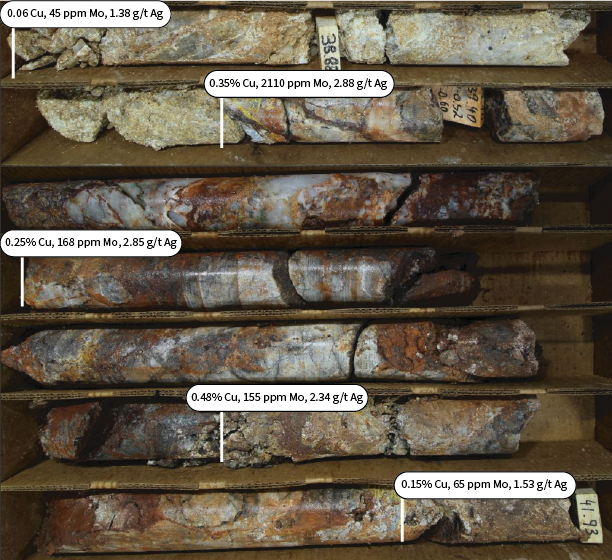
Figure 3. Oxidized quartz vein mineralization in quartz dacite porphyry cupola contact with completely recrystallized limestone host. Copper-molybdenum-silver grades are strongest where high temperature fluids in the porphyry intrusion interact with carbonate and dump out metals, 39 – 42 m, Hole 001.
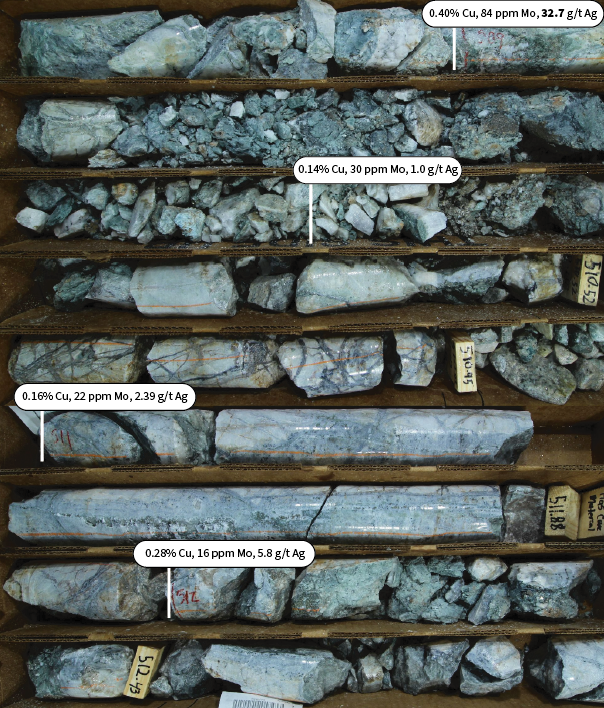
Figure 4. Unoxidized and dolomitized marble with pyroxene – garnet stockwork veining above quartz biotite porphyry stock in hole 002. This high temperature alteration assemblage dominates the bottom of both holes 1 and 2. Quartz veining with nontronite (clay) after pyroxene selvages fracture easily but carry higher grades of silver and copper.
Copyright (c) 2024 TheNewswire – All rights reserved.

